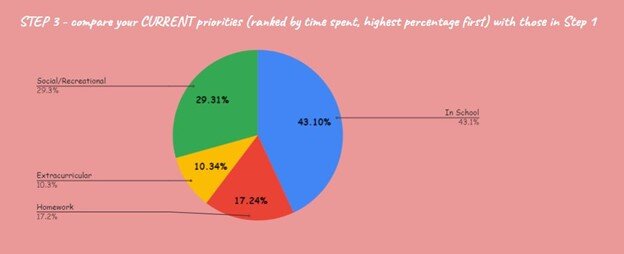Aligning your children’s priorities with their activities
One of the first things I check when working with students on their study habits is the alignment between their current priorities (or those assigned to them by their parents or teachers) and their weekly activities. I’m primarily concerned with two things: consistency of these priorities with the student’s actual schedule, and a balance of mental, physical, emotional, and social activities. The lack of this consistency can lead to frustration for both student and parents, because there will be no easily identifiable reason why the goals set by those priorities aren’t being reached. The lack of balance, moreover, serves only to exacerbate any discrepancy between what we say we want to do and what we’re actually doing.
In other words, the first step to solving any problem of low grades, disorganization, lack of motivation, etc., is to hold a mirror up to what IS taking place, literally, as opposed to what we FEEL is taking place.
To this purpose, I use a very simple process of ‘numbers don’t lie.’ I decided to share it with you because, over the past 25 years that I’ve been working with high school students on their learning habits, the misalignment between what the students and parents want to achieve and the way they go about achieving it is becoming greater. I will share my opinion of why this may happen in subsequent posts.
But for now, here are 3 STEPS you can perform alongside your daughter or son, to ensure that the results you seek are being supported by the amount of time resources given to them. So get your pen and paper AND a calculator ready and let’s do this! (or click HERE for a link to Use/Download a spreadsheet)
STEP 1. Write down your current three top priorities for your son/daughter, from most to least important. To be consistent with the second part of this process, please choose from one of these three priorities:
LEARNING: meaning good grades, a demonstrated ability to apply information learned in school, an increasingly wider spectrum of interests based on classwork and, yes, HOMEWORK, etc.
EXTRACURRICULAR: this includes sports, clubs, play/musical rehearsals, and all other school-sponsored activities that require time commitment from student)
SOCIAL/RECREATIONAL: although I break those types of activities up when working with students (for important reasons), keeping them in the same category right now will not harm the effectiveness of this exercise.
STEP 2. For EACH DAY of an ‘average week’ (one with the most typical schedule), figure out how many hours are spent on each of the following categories and enter that number in the respective day:
1) In School
2) Doing Homework ( I tend not to count homework done at school during lunch period in the cafeteria while I’m socializing with my friends, for the reason that, while the homework might be getting done, the amount of ‘learning’ is significantly less. And it is the ‘learning’ that will ensure I can do well on a test a week after this homework, for example)
3) Committed to Extracurricular activities (I often measure from the time you arrive to the time you leave the place of activity - i.e., I may have rehearsal from 3-6pm, but I don’t get to leave the theater until 6:30pm because of clean-up)
4) Social/Recreational activities - as I mentioned above, these should eventually be separated because they serve two completely different functions, but it’s OK to sum them for now. DO NOT FORGET to include TIME SPENT ON SOCIAL MEDIA (SnapChat, IG, etc.) - we’ll have more to say on that in a future post.
STEP 3. Take the three highest percentages (DO NOT include the 'In School' category) from your result and write them in order from greatest to least next to the ones you entered in step 1.
How did you do?! Are all of them aligned? Most of them? … none :( ?
Non-alignment doesn’t always signal something is wrong. But it should always invite a second look and a conversation. In future posts, I’ll share some of the situations I’ve come across and I’ll present possible interpretations of a misalignment.





